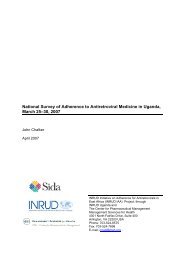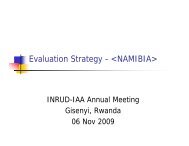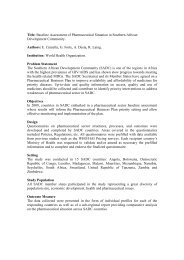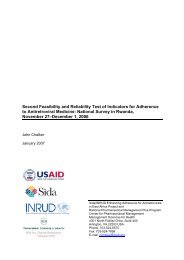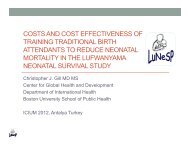How to investigate levels of Adherence to antiretroviral ... - INRUD
How to investigate levels of Adherence to antiretroviral ... - INRUD
How to investigate levels of Adherence to antiretroviral ... - INRUD
You also want an ePaper? Increase the reach of your titles
YUMPU automatically turns print PDFs into web optimized ePapers that Google loves.
<strong>How</strong> <strong>to</strong> Investigate <strong>Adherence</strong> <strong>to</strong> Antiretroviral Treatment:<br />
An Indica<strong>to</strong>r-Based Approach<br />
There is a difference between having a series <strong>of</strong> small gaps and one long gap in terms <strong>of</strong><br />
adherence. For this reason the other indica<strong>to</strong>r measures the rate <strong>of</strong> patients with gaps in<br />
treatment <strong>of</strong> 30 days or more. Between the four countries in the feasibility trial, this varied<br />
from 2 <strong>to</strong> 18% <strong>of</strong> patients, but in the worst facility 60% <strong>of</strong> patients had such a gap. This may<br />
be because people dropped out permanently through defaulting or death, or that they<br />
remained in treatment. This would be an important follow-up question.<br />
Indica<strong>to</strong>r 3. Percentage <strong>of</strong> patients who experienced a gap in ARV<br />
availability <strong>of</strong> more than 30 days in a row during a defined period<br />
Rationale<br />
Source <strong>of</strong> data<br />
Data collection<br />
A gap in medicine supply <strong>of</strong> more than 30 days has serious implications for<br />
resistance and treatment failure.<br />
Pharmacy records.<br />
Based on the same sample <strong>of</strong> 100 patients and the same data on dates <strong>of</strong><br />
dispensing and number <strong>of</strong> days dispensed since the index visit.<br />
Computation For individual patient: Discontinuation—If patient ever experiences a gap <strong>of</strong> > 30<br />
days between the end <strong>of</strong> days’ supply in one dispensing (or end <strong>of</strong> <strong>to</strong>tal days’<br />
supply available if ARVs remain from previous dispensings) and date <strong>of</strong> the next<br />
dispensing<br />
Comments<br />
For facility: Percentage discontinuation (number <strong>of</strong> patients experiencing a gap in<br />
ARV treatment > 30 days/number <strong>of</strong> patients) × 100.<br />
This can be calculated au<strong>to</strong>matically using the spreadsheet analysis <strong>to</strong>ol.<br />
Pitfalls<br />
As with the previous indica<strong>to</strong>r, identifying reliable patient-specific longitudinal<br />
records may be a problem in some systems, if one visit is not recorded then the<br />
patient will appear <strong>to</strong> have a gap <strong>of</strong> 30 days, so a low measure on the indica<strong>to</strong>r<br />
may reflect poor record keeping.<br />
Patient attendance and defaulting measure<br />
A missed appointment should trigger programme action <strong>to</strong> reach out <strong>to</strong> patients at risk <strong>of</strong><br />
defaulting on their treatment. <strong>How</strong>ever, because the patient may have had extra days <strong>of</strong><br />
medicine, attendance failure within three days <strong>of</strong> an appointment can also be a trigger point.<br />
The two core performance indica<strong>to</strong>rs related <strong>to</strong> attendance are:<br />
4. Percentage <strong>of</strong> patients who attend on or before the day <strong>of</strong> their appointment.<br />
5. Percentage <strong>of</strong> patients who attend within three days <strong>of</strong> their appointment.<br />
The purpose is <strong>to</strong> look at a visit the patient made, note when the next appointment was<br />
made for, and then see if the patient kept the appointment. Because some programmes give<br />
certain patients three months <strong>of</strong> medicine, it is necessary <strong>to</strong> review the records <strong>to</strong> see the<br />
patient’s attendance four months before, see the date <strong>of</strong> the next appointment, and then note<br />
whether the patient’s next visit was on or before that date (indica<strong>to</strong>r 4), or within three days<br />
<strong>of</strong> that date (indica<strong>to</strong>r 5).<br />
12



